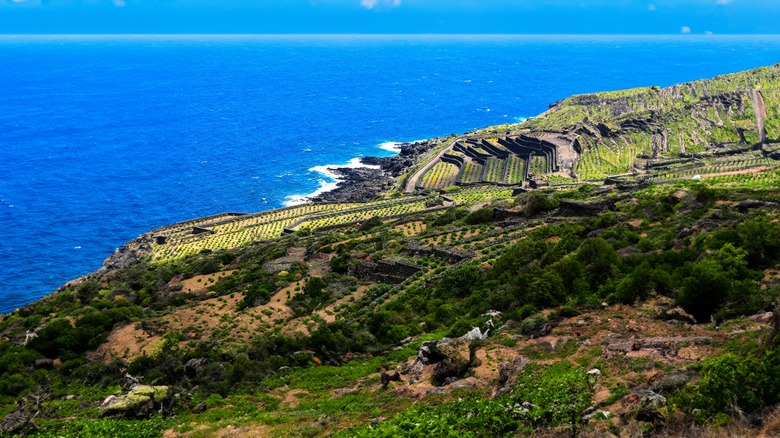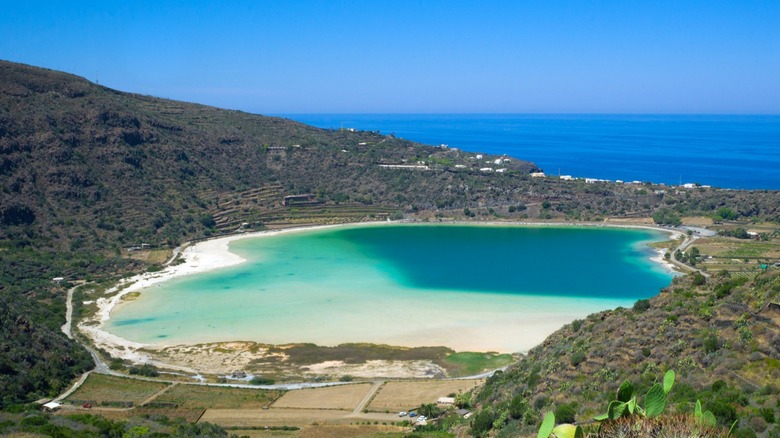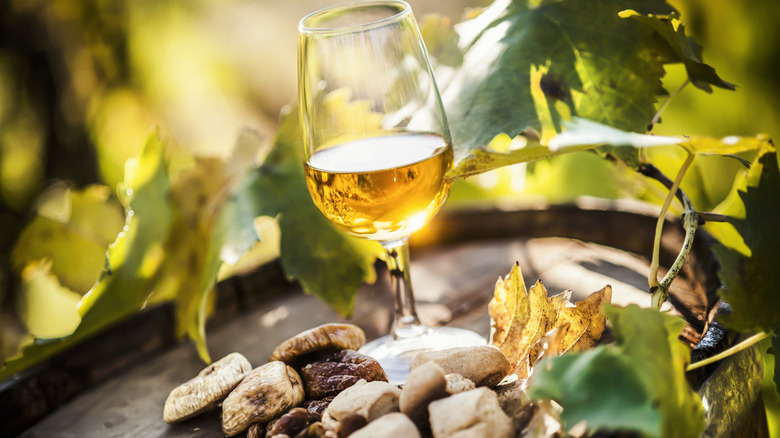An Italian Island With Healing Hot Springs Is Known As The 'Black Pearl Of The Mediterranean'
Islands throughout Italy are known for their stunning sandy beaches, trendy beach clubs, and see-and-be-seen vibes. Today's venture takes readers to a place completely different from a typical island vacation. That's not to say that beauty can't be found in this destination, far from it. Located 60 miles southwest of Sicily and 30 miles east of Tunisia lies the "Black Pearl of the Mediterranean," Pantelleria. This tiny volcanic island is known for its rugged cliffs, traditional Arabic stone homes called dammusi, natural thermal springs, and stretches of stunning vineyards — renowned for their production of a sweet dessert wine aptly named Pantelleria. Although perhaps not a traditional vacation spot, it embodies a serene island escape, like Alicudi — the perfect place for an isolated Italian getaway.
The few who have heard of this underrated Italian island may be familiar with it if they've ever watched Luca Guadagnino's 2015 film "A Bigger Splash," which put Pantelleria on the map. This crime-thriller film portrays the island in a beautiful sun-soaked light, showcasing its ancient volcanic craters, grapevine-terraced cliffs, narrow winding roads, and a stunning jagged coastline. Here on this island, locals spend their days sunbathing atop large lava rocks while the turquoise sea glimmers below.
Unwind in Pantelleria's thermal pools
Because the island was formed by volcanic activity, Pantelleria is now home to some of the best natural hot springs in the world and open-air spas. The Lago Specchio di Venere, or Mirror of Venus Lake, is considered to be one of the most unique locations on the island. The name comes from local legend, which states that Venus used to visit the crystal clear waters to admire her reflection, before meeting with Bacchus, the God of Wine. The waters in this lake are not only beautiful, but also rich in sulfur, minerals, and nutrients. The volcanic mud at the bottom is said to be great for the skin, and the temperature of the water remains between 104 to 122 degrees Fahrenheit. All this makes it the perfect location for visitors to relax and unwind.
About a 22-minute drive from the lake is Grotta di Benikulà, a small natural sauna (free of charge) with temperatures reaching a comfortable 104 degrees Fahrenheit. Visitors to this lovely grotto need only bring their own swimming gear. From here, visitors can travel to Grotte di Sataria, a series of three pools famous for their thermal waters rich in minerals, and said to be the location where Ulysses met the goddess Calypso. Another great natural wonder that can't be missed is the most visited landmark on the island, the iconic Elephant's Arch, a land mass in the shape of an elephant dipping its trunk into the water. Another great thing about visiting here is that although the island is known for being windy, the "elephant" separates the bay in two and the water on one side is usually calm.
Learn about Pantelleria's historic wine tradition
What better way to continue a day of relaxation than by sipping on some delicious, sweet wine? Pantelleria was under Arabic rule from 700 AD until 1123 when Roger II of Sicily reclaimed the island. This influenced not only the architecture on the island (like the dammusi mentioned above) but also the type of grapes used in their wine production. The island's most popular grape, Zibibbo, means "raisin" in Arabic, from which comes moscato and passito — both sweet dessert wines. Being that the island is one large volcanic mass surrounded by salt water and blasted by harsh, hot winds, it should seem impossible that grapes could grow here. Surprisingly, the Zibibbo grape is right at home on the island, as it thrives in hot climates like the one found on Pantelleria.
With such intense winds, how do the vines not blow over? Thousands of years ago the people of Pantelleria invented an interesting method called alberello pantesco, which happens to be the only agricultural practice recognized by UNESCO today. Following this ancient method, vines are cultivated in shallow holes and pruned low to the ground, protecting them from the island's incessant winds. Visitors to the island can taste this delicious sweet wine and learn more about its production by stopping by bucket-list Italian wineries like Cantina Basile or Marco De Bartoli in Bukkuram, Abbazia San Giorgio in Mueggen, or the Donnafugata estate in Khamma.


